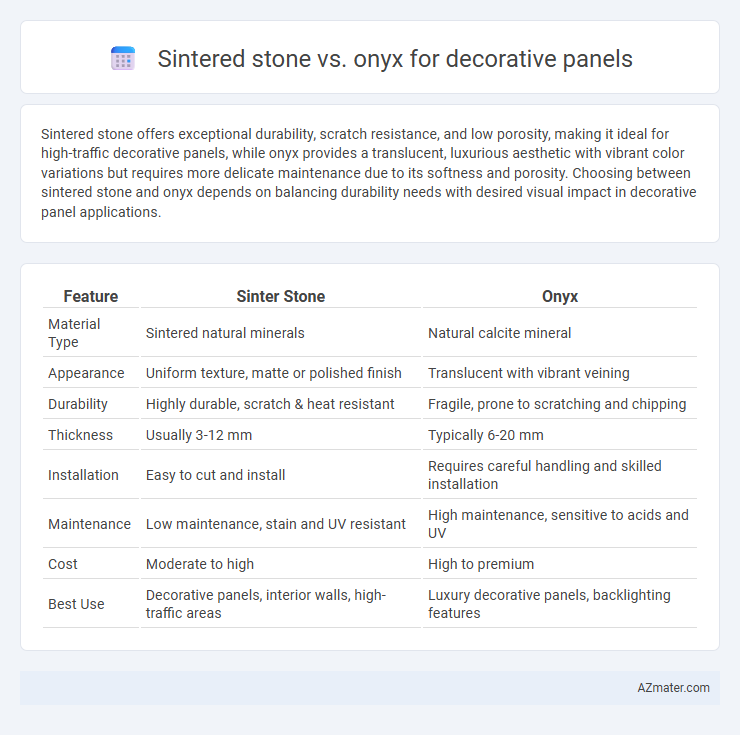Sintered stone offers exceptional durability, scratch resistance, and low porosity, making it ideal for high-traffic decorative panels, while onyx provides a translucent, luxurious aesthetic with vibrant color variations but requires more delicate maintenance due to its softness and porosity. Choosing between sintered stone and onyx depends on balancing durability needs with desired visual impact in decorative panel applications.
Table of Comparison
| Feature | Sinter Stone | Onyx |
|---|---|---|
| Material Type | Sintered natural minerals | Natural calcite mineral |
| Appearance | Uniform texture, matte or polished finish | Translucent with vibrant veining |
| Durability | Highly durable, scratch & heat resistant | Fragile, prone to scratching and chipping |
| Thickness | Usually 3-12 mm | Typically 6-20 mm |
| Installation | Easy to cut and install | Requires careful handling and skilled installation |
| Maintenance | Low maintenance, stain and UV resistant | High maintenance, sensitive to acids and UV |
| Cost | Moderate to high | High to premium |
| Best Use | Decorative panels, interior walls, high-traffic areas | Luxury decorative panels, backlighting features |
Introduction to Decorative Panels: Sinter Stone vs Onyx
Sinter Stone offers high durability and resistance to scratches, making it ideal for long-lasting decorative panels with a natural appearance. Onyx provides a translucent, luxurious aesthetic with unique color variations, enhancing interior spaces through backlighting effects. Both materials deliver distinctive visual appeal but differ significantly in strength, price, and maintenance requirements for decorative panel applications.
Material Composition: Sinter Stone and Onyx Explained
Sinter stone is an engineered material composed of natural quartz, feldspar, and other minerals fused under high heat and pressure, resulting in a dense, durable surface ideal for decorative panels. Onyx, a natural stone formed from calcite with translucent and layered patterns, offers a striking aesthetic but is softer and more susceptible to scratching and etching. The difference in mineral composition gives sinter stone enhanced strength and resistance, while onyx provides unique visual appeal with its natural veining and translucency.
Aesthetic Appeal: Comparing Visual Impact
Sintered stone offers a consistent, matte finish with subtle textures that mimic natural stone, providing a modern and understated elegance for decorative panels. Onyx features translucent qualities and vibrant, intricate veining that create a striking, luminous visual impact, making it ideal for dramatic and luxurious interior applications. The choice between sintered stone and onyx depends on desired light interaction and design ambiance, with sintered stone excelling in durability and uniformity, while onyx delivers unparalleled depth and brilliance.
Durability and Strength: Which Lasts Longer?
Sinter stone offers exceptional durability and resistance to scratching, heat, and impact, making it ideal for high-traffic decorative panels. Onyx, while visually stunning with its translucent properties, is softer and more prone to cracking and chipping under stress. For long-lasting strength and sustained performance in decorative applications, sinter stone generally outperforms onyx.
Maintenance Requirements: Ease of Cleaning and Care
Sinter stone offers superior resistance to stains and scratches, making it remarkably easy to clean with just mild soap and water, requiring minimal maintenance for decorative panels. Onyx, being a softer and more porous natural stone, demands regular sealing and gentle cleaning with non-abrasive products to prevent etching and discoloration. Choosing sinter stone reduces long-term maintenance efforts, while onyx requires careful upkeep to preserve its aesthetic appeal.
Cost Comparison: Initial Investment and Long-Term Value
Sinter stone typically offers a lower initial investment cost compared to onyx, making it a budget-friendly option for decorative panels. Despite the higher upfront price, onyx provides long-term value through its unique translucency and luxurious aesthetic that can increase property appeal and resale value. Maintenance and durability favor sinter stone, reducing long-term expenses and making it cost-effective over time despite its lower initial cost.
Environmental Sustainability: Eco-Friendly Choices
Sintered stone offers superior environmental sustainability due to its manufacturing process that utilizes natural minerals and requires less energy compared to onyx extraction, which involves intensive quarrying and significant waste. Onyx, although visually striking, often faces criticism for its environmental impact due to non-renewable resource depletion and high transportation emissions. Choosing sintered stone for decorative panels supports eco-friendly building practices by minimizing carbon footprint and promoting resource efficiency.
Installation Processes: Challenges and Advantages
Sinter stone offers lightweight properties and pre-finished surfaces that simplify cutting and fastening during decorative panel installation, reducing labor time and minimizing dust compared to onyx. Onyx panels, prized for their translucent aesthetics, demand careful handling due to fragility and require precise backing and specialized mounting hardware to prevent cracking and support weight. Both materials benefit from professional installation techniques, but sinter stone's durability and ease of manipulation present fewer challenges on-site than the complex and delicate process required for onyx panels.
Application Versatility: Indoor and Outdoor Uses
Sinter stone offers exceptional durability and resistance to weather elements, making it ideal for both indoor and outdoor decorative panels, including facades and garden walls. Onyx, prized for its translucency and elegance, is primarily used indoors in settings like feature walls and backlit panels where it is protected from UV exposure and moisture. The versatility of sinter stone extends to high-traffic and harsh environments, while onyx is best suited for controlled indoor applications emphasizing aesthetic appeal.
Choosing the Right Material for Your Decorative Panel
Sinter stone offers exceptional durability and resistance to heat and scratches, making it ideal for high-traffic and outdoor decorative panels. Onyx provides a unique translucent aesthetic, enhancing interior spaces with its natural veining and vibrant colors, but requires careful maintenance due to its relative softness. Selecting between sinter stone and onyx depends on balancing durability needs with design preferences and maintenance considerations for your decorative panel.

Infographic: Sinter stone vs Onyx for Decorative panel
 azmater.com
azmater.com